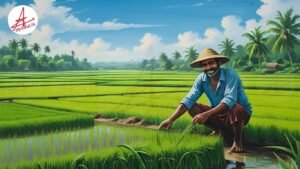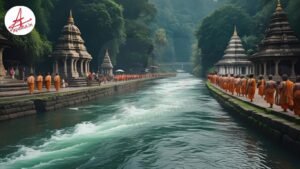Indus River System
- Origin: Tibetan Plateau (near Lake Mansarovar)
- Course: Flows westward through India, Pakistan, and Afghanistan
- Major Tributaries:
- Jhelum: Originates in the Pir Panjal Range, flows through Kashmir Valley
- Chenab: Formed by the confluence of Chandra and Bhaga rivers in Himachal Pradesh
- Ravi: Originates in the Chamba district of Himachal Pradesh
- Beas: Originates in the Beas Kund, Himachal Pradesh
- Sutlej: Originates in the Tibetan Plateau, flows through Himachal Pradesh
- Importance: The Indus system supports agriculture in Pakistan’s Punjab region and has historical significance as one of the cradles of ancient civilization.
Ganges River System
- Origin: Gangotri Glacier, Himalayas
- Course: Flows eastward through Uttarakhand, Uttar Pradesh, Bihar, West Bengal, Bangladesh, and merges with Brahmaputra to form the Padma River
- Major Tributaries:
- Yamuna: Originates in the Yamunotri Glacier, Himachal Pradesh
- Ghaghra: Originates in the Tibet Autonomous Region
- Gandak: Originates in the Tibet Autonomous Region
- Kosi: Known for its frequent floods, originates in the Tibet Autonomous Region
- Mahananda: Originates in the Darjeeling Hills of West Bengal
- Importance: The Ganges is considered sacred in Hinduism, vital for agriculture, and a major source of water for millions.
Narmada River
- Origin: Amarkantak Plateau, Madhya Pradesh
- Course: Flows westward through Gujarat, empties into the Arabian Sea
- Major Features: It is one of the few major rivers in India to flow westward.
- Importance: The Narmada is crucial for irrigation, hydroelectric power, and supports the Sardar Sarovar Dam project.
Tapi River
- Origin: Amarkantak Plateau, Madhya Pradesh
- Course: Flows westward parallel to the Narmada, empties into the Arabian Sea
- Importance: Like the Narmada, it is vital for irrigation in Gujarat and Maharashtra.
Godavari River
- Origin: Western Ghats, Maharashtra
- Course: Flows eastward, forms a delta in Andhra Pradesh before emptying into the Bay of Bengal
- Major Tributaries:
- Pench, Wainganga, Penganga, and Tapi
- Importance: Known as the “Ganges of the South,” it supports a significant part of the country’s agriculture and provides water for several major cities.
Krishna River
- Origin: Western Ghats, Maharashtra
- Course: Flows eastward, forms a delta before emptying into the Bay of Bengal
- Major Tributaries:
- Tungabhadra, Bhima, and Koyna
- Importance: It is essential for irrigation in Andhra Pradesh and Karnataka and supports various hydroelectric projects.
Kaveri River
- Origin: Western Ghats, Karnataka
- Course: Flows southward, forms a delta before emptying into the Bay of Bengal
- Major Tributaries:
- Bhavani, Kabini, and Hemavati
- Importance: It is crucial for agriculture in Tamil Nadu and Karnataka and is known for the Kaveri Water Dispute.
Brahmaputra River
- Origin: Tibetan Plateau (Angsi Glacier)
- Course: Flows eastward through Assam, merges with the Ganges in Bangladesh to form the Padma River
- Major Tributaries:
- Dibang, Lohit, and Teesta
- Importance: It supports agriculture, provides water for the northeastern states, and is crucial for the biodiversity of the Brahmaputra Valley.
Mahanadi River
- Origin: Eastern Ghats, Chhattisgarh
- Course: Flows eastward, forms a delta before emptying into the Bay of Bengal
- Major Tributaries:
- Jonk, Seonath, and Tel
- Importance: It is important for irrigation and hydroelectric power in Odisha.
Subarnarekha River
- Origin: Chota Nagpur Plateau, Jharkhand
- Course: Flows eastward, forms a delta before reaching the Bay of Bengal
- Major Tributaries:
- Karo, Kangsabati
- Importance: It is essential for local agriculture and provides water for Jharkhand and West Bengal.
Luni River
- Origin: Aravalli Range, Rajasthan
- Course: Flows westward, eventually disappearing into the Thar Desert
- Major Tributaries:
- Bandi, Jawai
- Importance: Supports local agriculture in Rajasthan despite its seasonal flow.
Peninsular Rivers: Characterized by their short length and steep gradients. They are heavily dependent on seasonal monsoons and are vital for irrigation in the southern states.
Coastal Rivers: These rivers, which flow directly into the Arabian Sea or the Bay of Bengal, are often short and seasonal. They play a role in local ecosystems and can be prone to flooding during the monsoon season.
India’s rivers are more than just water sources; they shape the culture, history, and economy of the regions they traverse. Their management and conservation are crucial for sustaining India’s agricultural and water needs in the face of changing climatic conditions.








